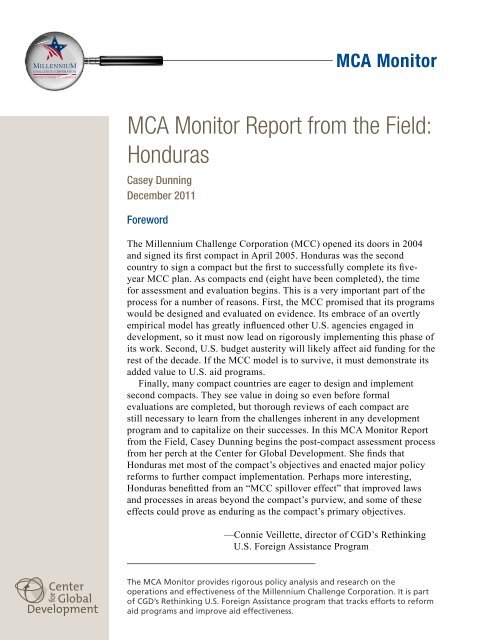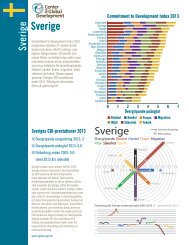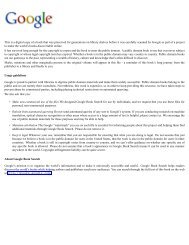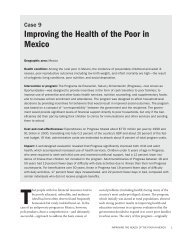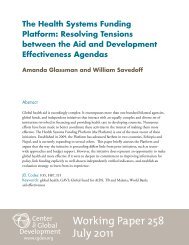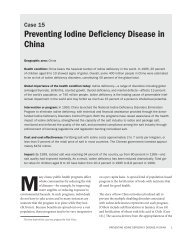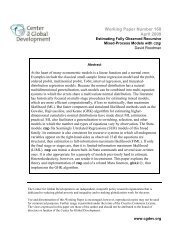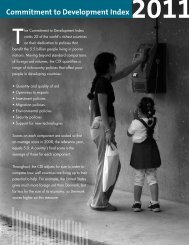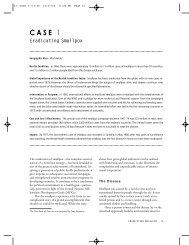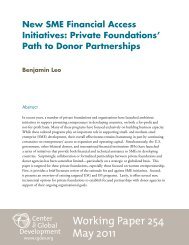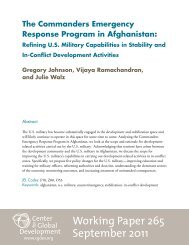Honduras - Center for Global Development
Honduras - Center for Global Development
Honduras - Center for Global Development
You also want an ePaper? Increase the reach of your titles
YUMPU automatically turns print PDFs into web optimized ePapers that Google loves.
MCA Monitor<br />
MCA Monitor Report from the Field:<br />
<strong>Honduras</strong><br />
Casey Dunning<br />
December 2011<br />
Foreword<br />
The Millennium Challenge Corporation (MCC) opened its doors in 2004<br />
and signed its first compact in April 2005. <strong>Honduras</strong> was the second<br />
country to sign a compact but the first to successfully complete its fiveyear<br />
MCC plan. As compacts end (eight have been completed), the time<br />
<strong>for</strong> assessment and evaluation begins. This is a very important part of the<br />
process <strong>for</strong> a number of reasons. First, the MCC promised that its programs<br />
would be designed and evaluated on evidence. Its embrace of an overtly<br />
empirical model has greatly influenced other U.S. agencies engaged in<br />
development, so it must now lead on rigorously implementing this phase of<br />
its work. Second, U.S. budget austerity will likely affect aid funding <strong>for</strong> the<br />
rest of the decade. If the MCC model is to survive, it must demonstrate its<br />
added value to U.S. aid programs.<br />
Finally, many compact countries are eager to design and implement<br />
second compacts. They see value in doing so even be<strong>for</strong>e <strong>for</strong>mal<br />
evaluations are completed, but thorough reviews of each compact are<br />
still necessary to learn from the challenges inherent in any development<br />
program and to capitalize on their successes. In this MCA Monitor Report<br />
from the Field, Casey Dunning begins the post-compact assessment process<br />
from her perch at the <strong>Center</strong> <strong>for</strong> <strong>Global</strong> <strong>Development</strong>. She finds that<br />
<strong>Honduras</strong> met most of the compact’s objectives and enacted major policy<br />
re<strong>for</strong>ms to further compact implementation. Perhaps more interesting,<br />
<strong>Honduras</strong> benefitted from an “MCC spillover effect” that improved laws<br />
and processes in areas beyond the compact’s purview, and some of these<br />
effects could prove as enduring as the compact’s primary objectives.<br />
—Connie Veillette, director of CGD’s Rethinking<br />
U.S. Foreign Assistance Program<br />
The MCA Monitor provides rigorous policy analysis and research on the<br />
operations and effectiveness of the Millennium Challenge Corporation. It is part<br />
of CGD’s Rethinking U.S. Foreign Assistance program that tracks ef<strong>for</strong>ts to re<strong>for</strong>m<br />
aid programs and improve aid effectiveness.
“As Hondurans, we only agree on two things: the Millennium Challenge Account<br />
and the national soccer team.” A Honduran MCA representative voiced this<br />
succinct observation, but stakeholders across the spectrum from the Honduran<br />
national government to the national business council to local farmers expressed<br />
similar sentiments about the achievements of the Millennium Challenge<br />
Corporation (MCC) compact in <strong>Honduras</strong>. The $205 million, five-year compact<br />
officially closed in September 2010, but its effects continue more than 14 months<br />
later. The compact directly benefitted the household incomes of more than 1.7<br />
million Hondurans (two out of every nine Hondurans), a significant influence<br />
considering the average Honduran earns $1,880 per year. And the compact’s<br />
activities continue to reach new beneficiaries as farmers who benefited from the<br />
compact train other farmers in their communities and as new users take advantage<br />
of rehabilitated roads.<br />
Readers familiar with the MCA Monitor Report from the Field series will note<br />
that this analysis is the second report focused on the compact in <strong>Honduras</strong>. 1 While<br />
the first report focused on compact development and early implementation, this<br />
report examines the enduring results of the compact more than a year after its<br />
official closeout. It identifies specific reasons why <strong>Honduras</strong>’s compact was able<br />
to achieve such marked results and, more important, sustain and grow them after<br />
the life of the compact. The report draws from interviews conducted with compact<br />
stakeholders and beneficiaries in <strong>Honduras</strong>, including members of the national<br />
and local Honduran governments, representatives of the Honduran private sector<br />
and civil society, beneficiary farmers, non-MCC international donors and lenders,<br />
and Cuenta del Desafío del Milenio, the accountable entity in <strong>Honduras</strong><br />
responsible <strong>for</strong> compact implementation (hereafter referred to as MCA-H). These<br />
interviews, in addition to publically available MCC data on the outcomes and<br />
outputs of the compact, offer an overview of the five-year partnership, the<br />
compact’s implementation record, and the lasting results the compact produced.<br />
<strong>Honduras</strong> was the second country to sign an MCC compact and the first country<br />
to successfully complete a five-year compact. Its $205 million compact focused<br />
on two main constraints to economic growth throughout <strong>Honduras</strong>: high<br />
transportation costs and low agricultural productivity. The transportation project<br />
used $120 million to rehabilitate integral portions of the CA-5 highway, the main<br />
1 Sarah Lucas, <strong>Honduras</strong> Field Report, MCA Monitor <strong>Center</strong> <strong>for</strong> <strong>Global</strong> <strong>Development</strong>,<br />
April 2007.<br />
1
artery of <strong>Honduras</strong>’s most productive agricultural areas, and to improve three key<br />
secondary roads. The rural development project invested $67.8 million across four<br />
activities:<br />
1. Farmer training and development to improve the business skills,<br />
productivity, and market access of agricultural producers on small and<br />
medium farms.<br />
2. Access to credit to enhance the availability of financial products to small<br />
farmers and increase credit to rural lending institutions.<br />
3. Agricultural public goods grant facility to promote agricultural<br />
innovations unique to <strong>Honduras</strong> and invest in improving the productivity<br />
of farmer collectives through irrigation.<br />
4. Rural road rehabilitation to improve feeder roads that connect farmers<br />
to local markets.<br />
Unlike many other MCC compacts with a single regional focus, investments in<br />
<strong>Honduras</strong> were comprehensive in their geographic scope. As evidenced in the<br />
figure below, both rural development and transportation projects had almost<br />
national coverage.<br />
Figure 1. MCC Investments throughout <strong>Honduras</strong><br />
Source: Cuenta del Milenio, <strong>Honduras</strong>.<br />
2
Equally comprehensive, but not as evident on a map, were the policy re<strong>for</strong>ms<br />
enacted by the government during compact implementation. After sometimes<br />
intense negotiations between the MCC, the MCA-H, and the government of<br />
<strong>Honduras</strong>, the following re<strong>for</strong>ms and laws were passed to enable successful<br />
implementation of the compact and to ensure that results would be sustainable.<br />
Secured Transactions Law: The law modified and improved the process<br />
<strong>for</strong> pledging collateral and <strong>for</strong>eclosing on liens and other types of<br />
collateral. (This law was a necessary precursor to the creation of a<br />
moveable property registry.)<br />
Weight Control Management Law: The government modified the writ<br />
of Fondo Vial, the Honduran national roads maintenance entity, to enable<br />
it to implement a weight control system on the road network.<br />
Fast Track Law: This law put into legislation the MCC’s complete<br />
resettlement process as the process that must be used <strong>for</strong> resettlement in all<br />
transportation infrastructure projects.<br />
The above policy re<strong>for</strong>ms and how they led to more sustainable results are<br />
discussed in detail below. But it is worth pointing out the incentive-effect of the<br />
MCC. These policy re<strong>for</strong>ms, difficult changes themselves, were triply difficult to<br />
legislate because the MCA-H and MCC had to work through three governmental<br />
transitions. The MCC’s large investment in <strong>Honduras</strong>—and the potential <strong>for</strong><br />
future compacts—necessitated a good-faith ef<strong>for</strong>t from all parties that provided<br />
the momentum to pass the above three laws to enable and sustain the work of the<br />
compact.<br />
The MCC’s investment in <strong>Honduras</strong> did not conclude with compact closeout. The<br />
agency began rigorous impact evaluations <strong>for</strong> <strong>Honduras</strong>’s compact roughly a year<br />
after its completion. Once completed, these evaluations will offer important<br />
in<strong>for</strong>mation on how many targets were met, how many beneficiaries were<br />
affected, and, most important, how much household income was affected by the<br />
compact’s interventions. Right now, post-compact results, compared to original<br />
targets, offer a preview into the overall impact of MCC investments in <strong>Honduras</strong>.<br />
3
Table 1. Results <strong>for</strong> Selected Per<strong>for</strong>mance Indicators<br />
Rural<br />
<strong>Development</strong><br />
Project<br />
Estimated<br />
Beneficiaries:<br />
357,401<br />
Estimated<br />
Benefits:<br />
$53 million<br />
continued next page<br />
Project<br />
Component<br />
Farmer<br />
Training and<br />
<strong>Development</strong><br />
Access to<br />
Credit<br />
Agricultural<br />
Public Goods<br />
Grant Facility<br />
Per<strong>for</strong>mance<br />
Indicator<br />
Farmers<br />
harvesting highvalue<br />
crops<br />
Hectares<br />
harvesting highvalue<br />
crops<br />
Number of<br />
farmers<br />
receiving TA<br />
Business plans<br />
prepared by<br />
farmers with TA<br />
Value of loans<br />
disbursed<br />
Number of loans<br />
disbursed<br />
Total number of<br />
loan recipients<br />
New<br />
technologies<br />
developed<br />
Number of new<br />
products<br />
developed <strong>for</strong><br />
agribusiness<br />
New hectares<br />
under irrigation<br />
Farmers<br />
connected to<br />
irrigation 3<br />
4<br />
Final<br />
Target 2<br />
Compact<br />
Period Actuals<br />
(as of Dec 2010)<br />
% Compact Target<br />
Satisfied<br />
(as of Dec 2010)<br />
6,000 6,029 101%<br />
8,400 9,287 111%<br />
8,255 7,265 88%<br />
6,960 16,119 232%<br />
$6 mil $10.7 mil 178%<br />
14,000 10,855 78%<br />
No target 5,951 No target required<br />
10 10 100%<br />
30 30 100%<br />
203 400 197%<br />
392 967 247%<br />
2 The compact targets changed during compact implementation because of increased<br />
construction costs, expansion of construction works, updates to the Monitoring and<br />
Evaluation plan, and project fund reallocations. The final targets are from the MCC’s<br />
Monitoring and Evaluation plan <strong>for</strong> <strong>Honduras</strong>, December 2010.<br />
3 As a result of the beneficiaries’ ownership of the project, more farmers have been<br />
incorporated than reported.
Transportation<br />
Project<br />
Estimated<br />
Beneficiaries:<br />
1,347,297<br />
Estimated<br />
Benefits:<br />
$185 million<br />
CA-5 Highway<br />
Secondary<br />
Roads<br />
Rural Roads 6<br />
Kilometers<br />
completed<br />
Road roughness<br />
on CA-5: T3.<br />
Baseline = 4<br />
(lower number =<br />
smoother road)<br />
Road roughness<br />
on CA-5: T4.<br />
Baseline = 4<br />
(lower number =<br />
smoother road)<br />
Kilometers<br />
completed<br />
Road roughness.<br />
Baseline = 13.6<br />
(lower number =<br />
smoother road)<br />
Kilometers<br />
completed<br />
5<br />
109 49.5 4 45%<br />
1.9 2.2 86%<br />
1.9 3.2 38% 5<br />
65.5 65.5 100%<br />
2.5 3.2 94%<br />
499 495.1 99%<br />
Source: This table is compiled from my analysis of Millennium Challenge Corporation<br />
data and the GAO Report MCC Compacts in Cape Verde and <strong>Honduras</strong> Achieved<br />
Reduced Targets, July 2011.<br />
Completed impact evaluations will build upon the results listed above and offer<br />
additional in<strong>for</strong>mation on the suspected increase in household incomes <strong>for</strong><br />
agricultural producers and road users, the change in traffic counts, and the<br />
reduction in travel time, among other measures.<br />
As the first compact to be successfully completed, <strong>Honduras</strong> held perennial<br />
<strong>for</strong>erunner status throughout its five years of implementation. It did not have the<br />
chance to benefit from any lessons learned and was a trailblazer in <strong>for</strong>mulating<br />
important lessons <strong>for</strong> future compact countries.<br />
4 The remaining kilometers are being completed through funding from the Central<br />
American Bank <strong>for</strong> Economic Integration (CABEI). As of December 20, 2011, the MCC,<br />
MCA-H, and CABEI had completed an additional 33 kilometers of the CA-5 highway.<br />
This means that 82.5 of the originally scoped 109 kilometers have been completed, or 76<br />
percent of the final target has now been met.<br />
5 The final target International Roughness Index (IRI) of 1.9 <strong>for</strong> section 4 of the CA-5<br />
highway was established <strong>for</strong> asphalt pavement. However, section 4 was rehabilitated with<br />
cement concrete which is inherently rougher due to the joints and flutes. For <strong>Honduras</strong>,<br />
an IRI value below 3.5 is considered a good level of smoothness.<br />
6 The Rural Roads activity is a component of the Rural <strong>Development</strong> project <strong>for</strong><br />
implementation purposes but is grouped with the Transportation project <strong>for</strong> evaluation<br />
purposes.
For <strong>Honduras</strong>, the time between compact signing and entry-into-<strong>for</strong>ce was a scant<br />
three months. (The compact average is 9.7 months.) This means that MCA-H<br />
spent precious amounts of its five-year clock setting up the accountable entity and<br />
putting fiduciary and procurement guidelines in place. The Ministry of Finance<br />
acted as the fiscal agent, an uncommon occurrence as most compact countries<br />
contract an external fiscal agent. This was an important step in building internal<br />
capacity, but it added to the compact implementation’s slow start after entry-into<strong>for</strong>ce<br />
since fiscal procedures had to be agreed upon and put in place be<strong>for</strong>e any<br />
disbursements could occur.<br />
In addition to a slow start in implementation, three government transitions<br />
occurred during the five-year life of the compact. (The compact entered into <strong>for</strong>ce<br />
in September 2005 and concluded in September 2010.) Ricardo Maduro led the<br />
Honduran government during compact development and the first months of<br />
compact implementation. Manuel Zelaya headed the government from January<br />
2006 to June 2009, when he was ousted. Roberto Micheletti led the interim<br />
government until Porfirio Lobo Sosa officially began his presidency in January<br />
2010. Some of the most crucial moments in the life of the compact—early<br />
implementation (as systems and structures are being put in place) and compact<br />
wind-down (as long-term sustainability planning should be happening with the<br />
partner government)—occurred during either a political transition or crisis.<br />
Further, as a result of the political crisis, the MCC board of directors terminated<br />
$10 million of the compact in September 2009 with just over a year left in<br />
implementation. Fortunately, the program was able to absorb the cut without<br />
sacrificing the integrity of the compact or its ultimate results. The partial<br />
termination ceased funding <strong>for</strong> a vehicle weight-control activity and <strong>for</strong> an<br />
uncommitted portion of rural roads which amounted to roughly 93 kilometers.<br />
The MCC’s compact in <strong>Honduras</strong> yielded notable results in both project outcomes<br />
and governmental policy re<strong>for</strong>ms. (Again, <strong>for</strong>thcoming impact evaluations will<br />
determine the overall impact on Honduran household income, the most crucial<br />
marker of success.) But many other compacts have enjoyed similar results; what<br />
specific lessons and models can <strong>Honduras</strong>’s compact provide <strong>for</strong> other MCC<br />
partner countries and the development community at large? Now, over 14 months<br />
later, one can begin to pinpoint attributes distinct to <strong>Honduras</strong>’s compact that led<br />
to robust set of results and helped to ensure the longevity of any impact. Below<br />
are four reasons why <strong>Honduras</strong>’s compact achieved sustainable results.<br />
6
For the MCC, it is not enough to post big outputs at the end of a compact. The<br />
compact must show results, and those results must be sustainable. That has been<br />
the case in <strong>Honduras</strong>, where program farmers have gone on to train new farmers<br />
and MCC-piloted processes have been institutionalized and replicated across the<br />
government. Such enduring effects multiply the benefits of the original gains.<br />
One sustainable policy re<strong>for</strong>m dictated by the compact was the passage of a<br />
Secured Transactions Law to facilitate the creation of a moveable property<br />
registry, an access-to-credit component of the rural development project. Passed<br />
in January 2010, this law allowed credit seekers to use an entirely new category of<br />
collateral. Its passage was a precondition of the compact that paved the way <strong>for</strong><br />
the creation of a moveable property registry that permits individuals and small<br />
and medium-sized entrepreneurs to offer items such as tractors, livestock, or<br />
accounts payable as collateral to access credit through <strong>for</strong>mal institutions. The<br />
government of <strong>Honduras</strong> continues to expand the registry and reach new credit<br />
seekers.<br />
As a testament to the innovation and sustainability behind this new law and<br />
registry, <strong>Honduras</strong>’s rank in the Doing Business Index’s Getting Credit sector<br />
rose from 37th in 2011 to 8th in 2012 in response to its improved credit<br />
in<strong>for</strong>mation and coverage. 7<br />
The MCC’s focus on sustainability extended to its resettlement model <strong>for</strong> the CA-<br />
5 highway and secondary roads. This model was so successful that the<br />
government adopted it, in full, into legislation <strong>for</strong> application to all other<br />
transportation projects. Nowhere in the compact was it mandated that the<br />
government legislate or widely use the MCC resettlement process.<br />
The MCC resettlement process raised the standard <strong>for</strong> resettlement in <strong>Honduras</strong>,<br />
offering houses, commercial livelihoods, and new access to water and electricity<br />
at 18 different sites. Crucially, those who were resettled also received the title to<br />
their new market-value land which could then be used to access credit. But the<br />
model was neither easy to get approved nor easy to implement. Developed from<br />
strict World Bank guidelines, the MCC’s resettlement process was far more<br />
rigorous than the government’s expropriation law, which dated back to 1972.<br />
Unlike the old process, the new MCC model mandated timely title issuance and<br />
payment <strong>for</strong> the market value price of land, rather than the cadastral value. To<br />
implement this new process, MCA-H developed a trust fund to make resettlement<br />
payments and procured an implementing entity to value land and provide<br />
technical assistance and social consulting services.<br />
7 The 2012 Doing Business Index: Measuring Business Regulations can be accessed at<br />
http://www.doingbusiness.org/rankings.<br />
7
The government of <strong>Honduras</strong> was so impressed with the MCC resettlement<br />
process that it adopted a new Fast Track Law that replicated the MCC<br />
resettlement scheme. In addition, the Inter-American <strong>Development</strong> Bank has also<br />
adopted the MCC resettlement policy <strong>for</strong> its transportation projects including a<br />
tandem portion of the CA-5 highway. The MCA-H did yeoman’s work to hammer<br />
out, test, and implement a difficult process that, once proved successful, was<br />
adopted by both the national government and other key donors. Thus the MCC<br />
was able to sustain its novel resettlement approach by proving that even the<br />
highest standards can be met.<br />
The MCC compact garnered another sustainability win in road maintenance even<br />
as a portion of the compact devoted to this cause was terminated. In September<br />
2009, the government of <strong>Honduras</strong> modified legislation pertaining to Fondo Vial,<br />
<strong>Honduras</strong>’s national road-maintenance entity, to enable it to implement a weight<br />
control system on the official road network. The compact required this<br />
modification, but it only came after intensive coordination between MCA-H and<br />
the government. That same month, the MCC board of directors terminated $10<br />
million from the Honduran compact including the weight control system that<br />
would assist in sustaining road maintenance. Even though the weight control<br />
activity was terminated from the official compact portfolio, the compact still<br />
leveraged a zero-cost legislative change to enable this activity. The government of<br />
<strong>Honduras</strong> has picked up where the MCC stopped and is actively pursuing other<br />
funding to construct and operate the weight control system based on the MCC’s<br />
design.<br />
The MCC also built sustainability into its transportation investments by focusing<br />
on improving the capacity and resources of Fondo Vial. In May 2010, the<br />
government of <strong>Honduras</strong> passed legislation to empower Fondo Vial to better<br />
address road-maintenance issues by strengthening the government’s roadmaintenance<br />
commitments and allocating budget to provide adequate funding<br />
(including but not limited to MCC-funded sections). Additionally as part of the<br />
compact agreement with MCC, the government of <strong>Honduras</strong> increased its own<br />
road-maintenance budget from $37 million in 2005 progressively to $64 million<br />
in 2010.<br />
It was not only policy re<strong>for</strong>ms that had lasting results; the compact’s farmer<br />
training and development program also had a number of intended and unintended<br />
sustainable effects. In the early stages of implementation, the MCC and MCA-H<br />
decided to scale back the number of farmers involved in the program and instead<br />
devote those funds to more intensive individual training that would ultimately be<br />
more sustainable. According to the Ministry of Agriculture, while other training<br />
programs stopped at crop cultivation, the compact’s program went further,<br />
helping farmers develop business skills and market acumen to produce what the<br />
market demands in any given season. It has now been two years since the<br />
training’s completion and not only do farmers’ yields and incomes continue to<br />
8
increase but many of the farmers are training other farmers within their<br />
communities in the program’s agricultural practices. Because of the success of the<br />
farmer training and development program, the Ministry of Agriculture is now<br />
looking <strong>for</strong> ways to adopt and implement the MCC model throughout its units.<br />
It is not often that an implementation model is touted as a result, but, in the case<br />
of the MCC, the model —and buy-in to it—is of paramount importance. Indeed,<br />
one international donor called the utilization and absorption of the MCC model<br />
the “biggest success” of the program. This may be a slight exaggeration, but the<br />
level of understanding and buy-in to the MCC model among national government,<br />
local government, the private sector, civil society members, and compact<br />
beneficiaries in <strong>Honduras</strong> was remarkable.<br />
Commitments to transparency, accountability, and results are hallmarks across the<br />
MCC compact portfolio, and the case was no different in <strong>Honduras</strong>. Many<br />
stakeholders referenced a change in mindset as a result of the MCC model. The<br />
model set expectations—<strong>for</strong> example, prompt payments and road completion<br />
within a stated time—that, when delivered upon, proved the MCC did business<br />
differently from other donors and lenders. One municipal leader described the<br />
MCC as “serious” in both purpose and process.<br />
One of the model’s trademarks that helped achieve results in <strong>Honduras</strong> was its<br />
strict timeline. The MCC model demands that projects be finished transparently<br />
within a five-year timeframe. This adherence to deadlines is anything but<br />
business-as-usual in <strong>Honduras</strong>, especially in road construction projects. As a<br />
comparison, another international funder undertook road rehabilitation and<br />
resettlement at a different portion of the CA-5 highway in 2006 that has yet to be<br />
completed. The MCC undertook a similar scope of work on its portion of the CA-<br />
5 highway in 2008 and finished in 2009. According to one government official,<br />
only the MCC starts and finishes according to its published plans.<br />
The MCA-H’s level of transparency and accountability <strong>for</strong> results garnered it a<br />
distinguished reputation with both the government and the public that continues<br />
well beyond the compact’s conclusion. Even other international donors have<br />
recognized the advantages of the MCC model in <strong>Honduras</strong>, calling on the MCA-<br />
H to implement other projects because its standards are so high and its projects<br />
per<strong>for</strong>med so well. One local mayor praised the MCC model as a model <strong>for</strong> other<br />
donors, calling it a “school on how to manage funds and run a program. The<br />
MCA-H administered [the compact] well, executed it well, and achieved the best<br />
results.”<br />
9
Compact results can be compromised <strong>for</strong> a number of reasons, one of which is a<br />
change in government. MCC accountable entities usually enjoy a certain level of<br />
autonomy and independence, but regime change can trigger delays in<br />
implementation as ministers change and a new political landscape must be<br />
navigated. The MCA-H worked under three different governments during its five<br />
years of implementation. 8 How were the MCC and MCA-H able to finish on time,<br />
on budget, and on target despite three changes in national government?<br />
The MCC and MCA-H maintained a singular focus on results that drove compact<br />
implementation and was transmitted to all governing entities involved in<br />
implementation. This focus engendered a similar commitment to obtaining results<br />
from successive governments. The <strong>Honduras</strong> compact design and MCC<br />
implementation model also reduced the discretion of the government: a<br />
transparent plan of implementation that was well-known throughout the country<br />
meant government entities were likely to stick to it or suffer public backlash.<br />
The MCA-H also had the <strong>for</strong>esight to bring in stakeholders early and often that<br />
would support the compact irrespective of the current government in power.<br />
MCA-H had strong engagement at the municipal level that allowed <strong>for</strong> the<br />
continuity of projects and buy-in from local government. It also consulted widely<br />
with civil society members during compact development and this level of<br />
engagement carried through implementation. MCA-H sought input from civil<br />
society throughout the life of the compact and included a strong civil society<br />
component on the MCA-H board. This, in turn, meant that civil society was quick<br />
to defend the compact from traditional politics and assist the MCA-H in carrying<br />
out implementation no matter the political climate. In fact, one civil society leader<br />
and MCA-H board member knew that the MCC model of assistance was<br />
exceptional when the compact was able to avoid political sea changes; he was<br />
shocked that the rules of the game did not change when a new government came<br />
into power in 2006.<br />
Rehabilitating 109 kilometers of the CA-5 highway was a huge task from the<br />
start, but during compact implementation construction and resettlement costs<br />
increased, the scope of work expanded, and portions of project fund were<br />
reallocated, making the project goal all but unattainable. Enter the Central<br />
American Bank of Economic Integration (CABEI). Because of the reputation and<br />
successful project implementation record of the MCA-H, CABEI agreed to help<br />
cover the higher construction and resettlement costs and the expanded scope of<br />
8 This count does not include the interim government from June 2009–January 2010.<br />
10
work on the CA-5 highway. The government of <strong>Honduras</strong> signed a $130 million<br />
loan with CABEI in December 2008 and an additional $28 million in early 2010.<br />
Because MCC funds were attached to the project, CABEI was able to provide<br />
concessional lending to the government.<br />
CABEI’s co-financing allowed <strong>for</strong> a doubling of kilometers rehabilitated and will<br />
increase both the impact and sustainability of the MCC-funded portions of the<br />
highway. MCA-H, MCC, and CABEI also worked together to ensure the MCC’s<br />
resettlement policy was applicable to the CABEI-funded portions of the CA-5<br />
highway. CABEI is not able to fund land acquisition <strong>for</strong> resettlement so the MCC<br />
contributed to the established resettlement trust fund to ensure that resettlement<br />
was carried out according to high MCC standards along the CA-5 highway.<br />
With a notable track record in compact implementation and policy re<strong>for</strong>m, the<br />
logical next question is: how will the MCC-<strong>Honduras</strong> partnership continue into<br />
the future? The MCC and the government of <strong>Honduras</strong> are in the midst of a policy<br />
improvement plan (PIP) designed to boost budget transparency and public<br />
financial management. In addition to improving policy in these areas, the PIP<br />
should also have a future effect on <strong>Honduras</strong>’s scores on the MCC’s fiscal policy<br />
and control of corruption indicators.<br />
The MCC began implementation of the PIP in March 2011 under a joint ef<strong>for</strong>t of<br />
the National Opinion Research <strong>Center</strong> at the University of Chicago, the<br />
International Budget Partnership, and Fundación Democracia sin Fronteras, a<br />
Honduran NGO. The PIP will collect supplemental in<strong>for</strong>mation and may play a<br />
role in addressing data time lags by updating budget and expenditure data last<br />
reported in September 2009 during the political crisis. Interim results are already<br />
available, and both areas show advances compared to 2009. Indeed, an assessment<br />
of budget transparency from September 2011 finds that the “Honduran<br />
government has taken significant steps to increase the public availability of key<br />
[budget] documents.” 9<br />
Following the PIP, Hondurans have their sights set on a second compact with the<br />
MCC. The MCC board of directors awards second compact eligibility on the basis<br />
of the following criteria:<br />
1. A country’s overall policy per<strong>for</strong>mance in three broad policy categories—<br />
ruling justly, investing in people, and encouraging economic freedom.<br />
9 “Assessment of Budget Transparency in <strong>Honduras</strong>,” The International Budget<br />
Partnership and the Fundación Democracia sin Fronteras, September 2011, p. 3.<br />
11
2. The MCC’s opportunity to reduce poverty and generate economic growth<br />
in a given country.<br />
3. A country’s compact implementation record (in the case of second<br />
compact consideration).<br />
4. The availability of funds to the MCC.<br />
<strong>Honduras</strong>’s track record on compact implementation and partnership with the<br />
MCC is, as discussed above, very good. Even as the MCC’s compact pioneer,<br />
<strong>Honduras</strong> was able to meet and exceed most of its targets while pushing tough<br />
policy re<strong>for</strong>ms to ensure the sustainability of the compact’s investments.<br />
The MCC’s unique opportunity to reduce poverty and generate economic growth<br />
is also high in <strong>Honduras</strong>. The reputation of the MCC and MCA-H is such that a<br />
second compact could pursue even more innovative development projects with<br />
the backing of the Honduran government and the public. Further, the MCA-H still<br />
exists as an implementing entity, meaning that key implementing, procurement,<br />
and fiscal procedures remain in place. (However, this will end in 2012 with the<br />
completion of the MCC-CABEI funded portion of the CA-5 highway.) From the<br />
U.S. development perspective, <strong>Honduras</strong> was selected as one of twenty countries<br />
<strong>for</strong> the Feed the Future initiative, a signature development initiative of President<br />
Obama. Current Feed the Future ef<strong>for</strong>ts are using many of the processes and<br />
systems from the MCC compact, and a second MCC compact could build upon<br />
Feed the Future ef<strong>for</strong>ts to further target agricultural production as a driver of<br />
economic growth.<br />
The availability of funds to the MCC is an important criterion to consider,<br />
especially considering the tight U.S. fiscal environment. Both Senate and House<br />
appropriators have set the MCC FY2012 funding level at $898 million in their<br />
respective FY2012 State, Foreign Operations bills. This level is roughly $325<br />
million below the president’s request and far below President Bush’s originally<br />
envisioned $5 billion annual MCC appropriation. The MCC board will have to be<br />
highly selective in allocating MCC’s scarce resources. 10<br />
Finally, the MCC board considers the policy per<strong>for</strong>mance results on a country’s<br />
indicator scorecard. Here, <strong>Honduras</strong> does very well except <strong>for</strong> falling just below<br />
the control of corruption median. <strong>Honduras</strong> passes 16 out of 20 indicators. 11 On<br />
10 For more in<strong>for</strong>mation on how the MCC board of directors should be selective in<br />
FY2012 eligibility decisions, see CGD’s Which Countries Will the MCC Board Likely<br />
Select as Eligible in FY2012? Round Nine of the Millennium Challenge Corporation,<br />
Casey Dunning and Owen McCarthy, November 2011.<br />
11 This assessment relates to <strong>Honduras</strong>’s per<strong>for</strong>mance on the MCC’s revised selection<br />
system. See Appendix A <strong>for</strong> <strong>Honduras</strong>’s FY2012 new indicators test scorecard.<br />
12
the four indicators it fails, it scores at or just below the median. The biggest<br />
concern is <strong>Honduras</strong>’s score on the control of corruption indicator, one of two<br />
hard hurdles in the MCC’s revised selection system. In theory, a restriction on<br />
corruption makes sense and is a hallmark of MCC selection endorsed by both the<br />
administration and Congress. In practice, countries that score just beneath the<br />
median, such as <strong>Honduras</strong>, get wrongly excluded from eligibility despite a<br />
measure of error inherent in the corruption scores.<br />
Figure 2 below illustrates this point. Control of corruption indicator scores are<br />
presented <strong>for</strong> 12 low income countries around the median threshold of zero. A<br />
green point indicates a country’s passing score and a red point indicates a failing<br />
score. Also displayed are 90 percent confidence intervals, the Worldwide<br />
Governance Indicator standard used to judge “significant” changes in<br />
governance. 12 Overlapping confidence intervals indicate statistically insignificant<br />
differences: even the highest scoring country displayed, Mongolia, is within the<br />
confidence interval of the lowest scoring country displayed, Togo.<br />
Figure 2. Control of Corruption Scores and Confidence Intervals, FY2012<br />
Low Income Countries<br />
0.6<br />
0.4<br />
0.2<br />
0<br />
-0.2<br />
-0.4<br />
-0.6<br />
Mongolia<br />
Moldova<br />
Comoros<br />
Benin<br />
Sierra Leone<br />
Central African<br />
Republic<br />
Thus <strong>Honduras</strong>’ score in the 47th percentile on control of corruption is<br />
statistically indistinguishable from Benin’s passing score just above the median,<br />
meaning <strong>Honduras</strong> is technically within the margin of passing the corruption hard<br />
hurdle. More important, <strong>Honduras</strong>’s absolute score on the control of corruption<br />
indicator has shown improvement.<br />
12 Daniel Kaufmann, Aart Kraay, Massimo Mastruzzi, “The Worldwide Governance<br />
Indicators: Methodology and Analytical Issues,” World Bank Policy Research Working<br />
Paper No. 5430, September 2010.<br />
13<br />
Nicaragua<br />
<strong>Honduras</strong><br />
Uganda<br />
Kenya<br />
Timor-Leste<br />
Togo
For its part, the government of <strong>Honduras</strong> has done much to prove its policy mettle<br />
and seriousness in combating corruption and increasing transparency. The<br />
government and National Anti-Corruption Council inaugurated a new corruption<br />
plan with concrete strategies to make government processes transparent, hold civil<br />
servants fully accountable, and explain to the public how and why government<br />
resources are allocated and managed.<br />
With regard to human rights protection, the government has created a new<br />
Ministry of Human Rights and has promoted legislative re<strong>for</strong>ms in the areas of<br />
gender protection, prisoners’ rights, and minority ethnic groups, among others. It<br />
has also established a new Sub-Secretariat within the Ministry of Security focused<br />
exclusively on promoting human rights protection.<br />
Of course, these measures do not guarantee immediate reductions in corruption<br />
levels or human rights offenses, but they do represent important legislative and<br />
administrative steps that the current government has taken to tackle governance<br />
problems.<br />
The real success of the MCC compact in <strong>Honduras</strong> was not just that it produced<br />
sustainable results but that the MCC model of aid—with its high standards—<br />
precipitated these results. The MCA-H led implementation and came up with<br />
solutions and policy prescriptions that were based on the Honduran context. The<br />
results-oriented MCC model ensured that program funds went to program<br />
beneficiaries and nowhere else, and high levels of transparency and accountability<br />
allowed civil society and the private sector to hold the government of <strong>Honduras</strong><br />
and the MCC accountable <strong>for</strong> their investments. The scope and sustainability of<br />
results is even more striking when the nature of MCC’s investments is considered.<br />
In many cases, MCC and MCA-H went into areas that neither the government nor<br />
the private sector wanted to go, such as developing a new hybrid coffee varietal, a<br />
new potato seed specifically <strong>for</strong> cultivation in <strong>Honduras</strong>, and a new type of<br />
irrigation system, or reaching never-be<strong>for</strong>e-trained farmers deep in the mountains<br />
<strong>for</strong> the farmer training and development program.<br />
<strong>Honduras</strong>’s compact experience offers important principles applicable to other<br />
MCC compacts seeking sustainable results.<br />
1. Incorporate sustainability plans early and often in compact design and<br />
implementation (and think about the post-compact environment as well).<br />
2. Promote an understanding of the MCC model of aid: the greater the buyin,<br />
the greater the results.<br />
14
3. Ensure the compact’s accountable entity has some level of autonomy and<br />
nongovernmental support to withstand any political changes.<br />
4. Leverage other sources of funding whenever and wherever possible to get<br />
even greater results out of a finite MCC resource commitment.<br />
Some of these lessons may seem obvious, but knowing them and implementing<br />
them are two very different things. The MCC and MCA-H went a long way in<br />
making <strong>Honduras</strong>’s compact successful by incorporating these principles<br />
throughout the life of the compact. Now, 14 months after the compact’s<br />
conclusion, both the MCC and <strong>Honduras</strong> can point to an impressive array of<br />
results that has continued to grow and benefit the people and economy of<br />
<strong>Honduras</strong>.<br />
15
Source: Millennium Challenge Corporation.<br />
16


